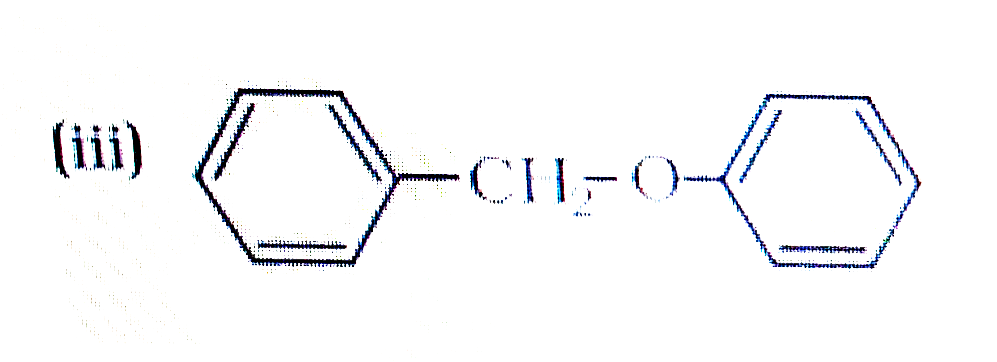CH3−CH=CH−CH2−CH3HI−−→Amajor
Compound A is
CH3−CH2−C∣∣H−CH2−CH3
CH3−C∣∣H−CH2−CH2−CH3
CH3−CH2∣C∣∣−CH2−CH3
CH3−CH3∣C∣CH3−CH2I
The correct Answer is:2
To solve the problem, we need to determine the major product (Compound A) formed when 1-pentene (CH₃-CH=CH-CH₂-CH₃) reacts with hydrogen iodide (HI).
1. Identify the Reactants:
The reactant is 1-pentene (CH₃-CH=CH-CH₂-CH₃) and it reacts with hydrogen iodide (HI).
2. Protonation of the Alkene:
The double bond in 1-pentene is attacked by the proton (H⁺) from HI. This can occur at either of the carbon atoms involved in the double bond:
- If the first carbon (C1) of the double bond is protonated, we get a carbocation at C2.
- If the second carbon (C2) of the double bond is protonated, we get a carbocation at C1.
3. Formation of Carbocations:
- Carbocation from C1 protonation:
CH₃-CH(+)-CH₂-CH₂-CH₃ (2° carbocation at C2)
- Carbocation from C2 protonation:
CH₃-CH₂-CH(+)-CH₂-CH₃ (2° carbocation at C1)
4. Stability of Carbocations:
- The stability of carbocations can be evaluated based on hyperconjugation and inductive effects.
- The carbocation formed by protonating C1 has 3 alpha hydrogens available for hyperconjugation.
- The carbocation formed by protonating C2 has 2 alpha hydrogens available for hyperconjugation.
- Therefore, the carbocation at C2 (from protonation at C1) is more stable due to having more alpha hydrogens (3 vs. 2).
5. Nucleophilic Attack by Iodide Ion:
The more stable carbocation (at C2) will be attacked by the iodide ion (I⁻) to form the final product.
6. Final Product (Compound A):
The major product (Compound A) is formed as follows:
- The structure of Compound A will be CH₃-CH₂-CH(I)-CH₂-CH₃.
Conclusion:
The major product (Compound A) formed from the reaction of 1-pentene with HI is CH₃-CH₂-CH(I)-CH₂-CH₃.
---
The reactant is 1-pentene (CH₃-CH=CH-CH₂-CH₃) and it reacts with hydrogen iodide (HI).
The double bond in 1-pentene is attacked by the proton (H⁺) from HI. This can occur at either of the carbon atoms involved in the double bond:
- If the first carbon (C1) of the double bond is protonated, we get a carbocation at C2.
- If the second carbon (C2) of the double bond is protonated, we get a carbocation at C1.
- Carbocation from C1 protonation:
CH₃-CH(+)-CH₂-CH₂-CH₃ (2° carbocation at C2)
- Carbocation from C2 protonation:
CH₃-CH₂-CH(+)-CH₂-CH₃ (2° carbocation at C1)
- The stability of carbocations can be evaluated based on hyperconjugation and inductive effects.
- The carbocation formed by protonating C1 has 3 alpha hydrogens available for hyperconjugation.
- The carbocation formed by protonating C2 has 2 alpha hydrogens available for hyperconjugation.
- Therefore, the carbocation at C2 (from protonation at C1) is more stable due to having more alpha hydrogens (3 vs. 2).
The more stable carbocation (at C2) will be attacked by the iodide ion (I⁻) to form the final product.
The major product (Compound A) is formed as follows:
- The structure of Compound A will be CH₃-CH₂-CH(I)-CH₂-CH₃.
The major product (Compound A) formed from the reaction of 1-pentene with HI is CH₃-CH₂-CH(I)-CH₂-CH₃.
Topper's Solved these Questions
- BOOK - AAKASH INSTITUTECHAPTER - HYDROCARBONSEXERCISE - Assignment(Section - B) (Obejctive type question)13videos
HYDROCARBONS
- BOOK - AAKASH INSTITUTECHAPTER - HYDROCARBONSEXERCISE - Assignment(Section - C) (Previous Years Questions)69videos
HYDROCARBONS
- BOOK - AAKASH INSTITUTECHAPTER - HYDROCARBONSEXERCISE - Exercise50videos
HYDROCARBONS
- BOOK - AAKASH INSTITUTECHAPTER - HALOALKANES AND HALOARENES EXERCISE - ASSIGNMENT SECTION -D15videos
HALOALKANES AND HALOARENES
- BOOK - AAKASH INSTITUTECHAPTER - HYDROGENEXERCISE - ASSIGNMENT (SECTION - D) (Assertion-Reason Type question)15videos
HYDROGEN
Similar Questions
Name the following compounds accoring to IUPAC system :
(i) CH3−CH2−CH∣CH2Cl−CH2OH∣CH−CH∣CH3−CH3(ii)CH3−CH∣CH3−CH2−CH∣OH−CH2OH∣CH−CH3
(iii) (iv) H2C=CH−CH∣OH−CH2−CH2−CH3
(iv) H2C=CH−CH∣OH−CH2−CH2−CH3
(v) CH3−C∣CH3=C∣Br−CH2OHView SolutionGive the major products that are formed by heating each of the following ethers with HI.
(i) CH3−CH2−CH3| CH−CH2−O−CH2−CH3
(ii) CH3−CH2−CH2−O−CH3∣C∣CH3−CH2−CH3
(iii) View Solution
View Solution
Knowledge Check
- Question 1 - Select One
CH3−CH3∣CH−CH2−CH3Cl2−−−−→UV light(A)major, The compound "A" is
ACH3−CH3∣CH−C∣ClH−CH3BCH3−CH3∣C∣Cl−CH2−CH3CCH3−CH3∣CH−CH2−CH2ClDCH3−CH2Cl∣C∣H−CH2−CH3 - Question 2 - Select One
CH3−Cl∣CH−CH2−CH3Pottasium tert. butoxide−−−−−−−−−−−−−−→AMajor is
ACH3−CH=CH−CH3BCH2=CH−CH2−CH3CCH3−CH3∣C=CH2DBoth (2) and (3) - Question 3 - Select One
In following compound
CH3−CH2−CH3∣C∣CH3−CH∣CH3−CH3∣CH−CH2−CH3
The correct lowest set of locant is :A3,3,4,5,B3,4,5,5C4,5,3,3D5,5,4,3
Number of 1∘ carbon in above compounds are:
CH3−CH2−CH2−CH∣CH3−CH−CH3−CH2−CH2−CH3∣CH−CH2−CH2−CH3∣C∣CH3−CH3View SolutionIn the given compounds
(A) CH3CH2CH2CH2−Br
(B) CH3−CH2−C∣BrH−CH3
(C) CH3−CH3∣C∣Br−CH3
The correct order of boiling point isView SolutionWrite the name of the given compound
CH3−CH2−CH2−C∣CH−CH3∣CH3H−CH2−CH2−CH2∣CH−CH3View SolutionThe major product (A) formed in the following reaction is
CH3−CH3∣CH−CH2−CH3−CH−CH3∣N∣CH3−⊕CH2−CH3OH−AΔView SolutionThe monomer of the polymer
~CH2−CH3∣C∣CH3−CH2−CH3∣C∣CH3~View Solution

